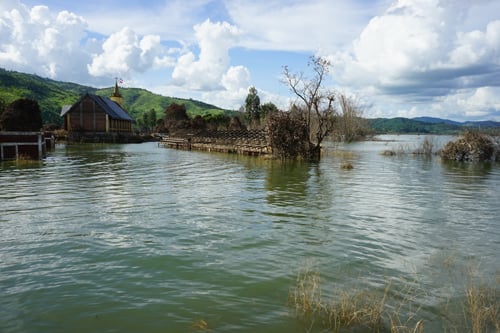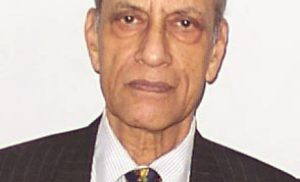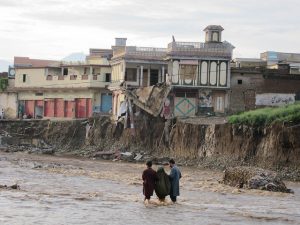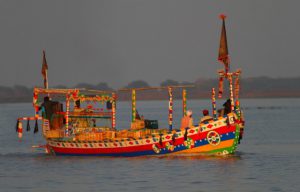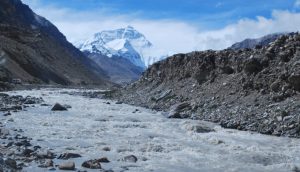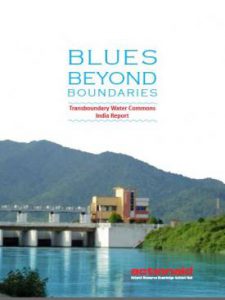The top spire of the Baptist Church stands as the lone sentinel to the once-flourishing Chadong village on the banks of the Thoubal River.
The Thoubal multipurpose dam was a mid-1970s plan of the Manipur government in north-east India. It envisaged constructing an earthen dam across the Thoubal River at Maphithel, in Thoubal and Ukhrul districts of Manipur. Work began in the early 1980s under the Irrigation and Flood Control Department (IFCD) of the state government.
The dam was meant to harness the Toubal River as it meanders its way from Manipur’s Ukhrul highlands to join the Chindwin River in Myanmar on the way to the Bay of Bengal. It was meant to irrigate the Thoubal Valley which is considered the rice bowl of Manipur, plus provide drinking water for state capital Imphal and adjoining areas.
[googlemaps https://www.google.com/maps/embed?pb=!1m18!1m12!1m3!1d2208591.0651598712!2d95.96086767461568!3d24.612083067018244!2m3!1f0!2f0!3f0!3m2!1i1024!2i768!4f13.1!3m3!1m2!1s0x3748e1fbc34e0eb9%3A0x186c48786681a1ef!2sChadong%2C+Manipur+795145%2C+India!5e0!3m2!1sen!2suk!4v1442333183605&w=480&h=286]
But trouble began almost at the same time as the construction. In the 1980s I was told by a retired official of the Indian Railways Service who belonged to the Tangkhul Naga tribe, “The benefits of the Thoubal dam will be reaped by the Meiteis in the (Imphal) valley; for that why should the Tangkhul Nagas suffer upstream?”
In terms of area, Manipur is 90% hills and 10% valley, though a majority of the people live in that 10%. Most hill residents are on India’s list of Scheduled Tribes. They have a long history of animosity with the valley residents, mostly from the ethnic group called Meitei.
The situation is further complicated by insurgent groups fighting to secede from India. The largest of them, the National Socialist Council of Nagaland (the Isak-Muivah faction, called NSCN-IM), had signed an accord with the Indian government in 1986. But that did not stop them from attacking the dam site the same year and killing two paramilitary guards.
The situation appeared to calm down after that and work progressed till 1992, when trouble flared up again over rehabilitation of villagers being displaced by the reservoir that was filling up behind the dam.
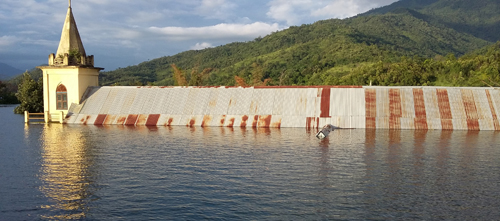
Tribal rivalries
And as usual in Manipur, the situation was immediately complicated by tribal loyalties and insurgencies. The Tangkhul Nagas objected when a village inhabited by members of the Kuki tribe was added to the rehabilitation list.
On top of that, in 1993 the then top bureaucrat of Ukhrul district Ram Muivah reportedly decided that the Rs. 1.5 crore (US$224,000 today) that was to be distributed among three Tangkhul Naga villages slated for submergence would be handed over to the three village headmen instead. According to media reports, all the money was taken by the NSCN insurgents, the people who lost their farms and homes never saw any of it.
Thoubal dam and its aftereffects then apparently fell off the media map till June 17 this year, when it was reported that Chadong village upstream of the dam is now being turned into a lake. At a local meeting, Chadong’s headman Wunganayao said that the government had built the dam without any consent from the people who would be affected in the aftermath of the construction.
Casting serious doubts on the rehabilitation process, Yumnam Jiten of the Citizens for Dams and Development said there were already two cases against the dam pending with the Manipur High Court and the National Green Tribunal, so the state government should immediately halt all construction.
But while the residents were talking, water was rising in the new artificial lake. It soon submerged Chadon village and even became a tourist attraction, while the Tangkhul Nagas who used to live in Chadong – once hunter gatherers and shifting cultivators – now had to learn how to become fishermen.
The village has splintered in the process. Of the 200 households in Chadon, 120 have accepted the compensation package of Rs 14 lakh (US$20,948) each. The rest are holding out. The government has promised to resettle everyone in a new village, but a visit to its site this August only showed a number of plots being levelled for houses. There was no school, dispensary, community hall, nor any sign that any would ever be built.
